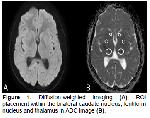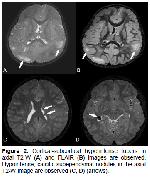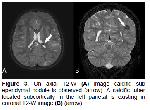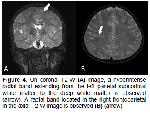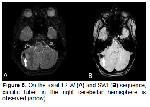Tuberous sclerosis complex is a congenital neurocutaneous syndrome also called tuberous sclerosis or Bourneville disease. Spontaneous mutations are observed in 50-90% of the patients, and others show autosomal dominant inheritance. Mutations in TSC1 and TSC2 genes were found in most of these patients
9,10. Its incidence has been reported as 1: 6000-10000
11. The main clinical findings are epilepsy, mental retardation, cognitive inefficiency and focal neurological deficits. A number of diagnostic criteria for the diagnosis of tuberous sclerosis patients have been created and were updated by the International Tuberous Sclerosis Complex Consensus Group in 2012
12. It is a disease that affects many organ systems such as skin, brain, eye, kidney, heart, lung and bone, and common central nervous system anomalies are observed
2. The main of central nervous system anomalies are cortical-subcortical tubers, subependymal nodules, subependymal giant cell astrocytoma and white matter abnormalities. Cortical or subcortical tubers are found in 80-95% of children diagnosed with TSC
13. Their number, size and localization differ. Most of the tubers are supratentorial and are often located in the frontal lobe
14.
MRI is a superior imaging method in determining central nervous system findings in patients with TSC, as it provides high soft tissue resolution. Diffusion-weighted MR imaging shows functional data based on microscopic movements of water molecules within the tissue 3. Microscopic structural changes affect the diffusivity of the tissue by preventing the random movement of water molecules. Disruption of the integrity of the cell membrane and axons or loss of myelin may result in increased ADC values by facilitating the movement of water molecules. It has been reported that diffusion-weighted imaging has significant contributions to conventional MRI by showing abnormalities in the cerebral parenchyma that is observed as normal 3. Therefore, diffusion-weighted imaging has been used in neurological diseases on the purpose of research cerebral parenchymal involvement. Alkan et al. 15 found that ADC values of the hippocampus and thalamus increased in patients diagnosed with neurofibromatosis type 1 compared to the control group. Besides, Eastwood et al. 16 demonstrated that ADC values of the basal ganglia in patients diagnosed with neurofibromatosis type 1 have increased compared to the control group. Görkem et al. 17 found increased ADC values in ipsilateral white matter and deep gray matter in patients diagnosed with isolated unilateral polymicrogyria compared to the control group. Garaci et al. 4 compared the ADC values of perilesional and contralateral normal appearing white matter in patients diagnosed with TSC with the control group and found that the supratentorial white matter values in patients with TSC were higher than the control group. Jansen et al. 18 compared ADC values of cerebral tubers with normal brain tissue symmetrically in patients with TSC and found that ADC values in tubers were significantly higher. Firat et al. 19 compared the ADC values of the normal appearing white matter and basal ganglia of 6 patients diagnosed tuberous sclerosis with the control group and found no significant difference. The ADC values of the bilateral caudate nucleus were found significantly higher than the control group in this study. Increased ADC values may indicate the presence of abnormal myelinization in these areas while indicating increased water content and decreased cell density.
Diffusion tensor imaging (DTI) is superior to diffusion-weighted imaging in evaluating the microanatomical structure of the cerebral parenchyma by providing information about the diffusion direction and size of water molecules. There are some studies using brain diffusion tensor imaging in patients diagnosed with tuberous sclerosis 20-22.
Because the limitations of this study was a study from single center, the patient population was low. The using of advanced MRI techniques such as DTI can provide more useful information because it provides more comprehensive information, but since this study is retrospective, the existing images were evaluated.
It has been shown that there are abnormalities in the caudate nuclei at the cellular level in patients diagnosed with TSC in this study. Affecting possible deep gray matter structures in these patients may explain the physiopathology for current clinical findings and neurological disorders that may develop.



